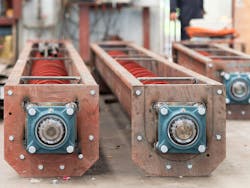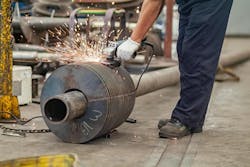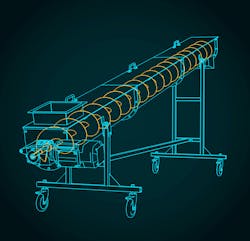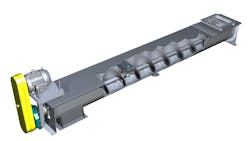Screw conveyors consist of a rigid rotating screw, or auger, within a trough or tube. As the screw rotates, it pushes material along the bottom of the trough.
In the most common style, the screw flighting is welded to a center shaft made of pipe. The shaft is driven (rotated) via an electric motor with a gear reducer or chain and sprocket to achieve the desired rotational speed. Screw speed is typically 30 to 60 rpm but can be as high as 150 rpm for some materials and applications.
To prevent the rotating screw from touching the trough, which would lead to wear and contamination from metal particles, hanger bearings are installed every ten feet or so to support the screw shaft and maintain a gap between the screw and the trough.
Screw conveyors are generally short to medium in length. Most are a few feet up to 40 feet long, but any length up to 150 feet is common. No curves or bends are possible. If a direction change is needed, then the material usually travels in one direction via one screw conveyor, then drops into another screw conveyor going in the second direction.
Screw conveyor sizing
Screw conveyor throughput is determined by the following equation:
Throughput = cross-sectional area x linear speed x bulk density x slope factor
The cross-sectional area of the material is the bottom portion of a circle covered with material and is determined by the following equation:
Cross-sectional Area = π/4 (D^2) %fill
The %fill is best determined with the support of the screw supplier, based on the material characteristics, and is kept well below the middle point to keep material from touching the bearings on the center shaft. A 30% fill is common for most normally flowing materials, but the fill percentage can vary from 15% to 40%.
The linear speed of the material equals the pitch distance times the rotation speed. Pitch is the length between screw flight segments and is the distance that material is pushed during one revolution of the screw.
The material’s bulk density can vary considerably depending on whether the material is loose, packed, or aerated. It is important to determine bulk density by measuring a sample of the actual material as it goes into the screw.
The slope factor indicates that horizontal conveying is most efficient. As the upward angle increases, more material will "fall back" instead of being conveyed along the upward slope. The estimated conveying capacity of average materials will be reduced by 5% for a 10-degree upward angle, 10% to 40% for a 20-degree angle, and 20% to 70% for a 30-degree angle. In other words, throughput suffers significantly as the upward angle increases. Throughput reduction can be overcome by using a bigger screw or turning it faster, but other conveying options may be better for free-flowing materials that tend to fall back down the screw.
Screw conveyor advantages
Screw conveyors are available in a large variety of standard configurations and sizes. Standard units are mass-produced, stocked as components, and then inexpensively and quickly assembled to order. This manufacturing efficiency makes them very cost-effective.
Small units can handle rates as low as grams per hour, while large ones can convey up to 50 tons per hour.
Multiple material inlets are routine. Multiple material outlets can be achieved by having several discharge points, each with a shut-off gate valve.
Many features, customizations, and process adaptations can be achieved with screw conveyors. For example:
- Mixing screws can have specially shaped blades (flighting) that convey most of the material forward but throw some of it backward to achieve mixing. Thus, many ingredients can be introduced simultaneously, and a homogeneous mixture can be discharged at the end.
- Heat transfer can be achieved by using a hollow screw or trough through which a heating or cooling fluid is circulated to heat or cool the material.
- Gravity flow of difficult material from bins and silos can be achieved by placing special screw conveyors at the outlet. If the screw conveyor has a large inlet that matches the bin outlet, then special screws with variable pitch or variable diameter can achieve mass flow discharge from the bin.
- Screw flighting is available in various shapes and geometries that can be advantageous for specific materials or applications.
Screw conveyor disadvantages
Screw conveyors convey material in a straight line; direction changes are not possible.
Because clearance is necessary between the trough and the bottom of the screw, a heel of material will remain in the gap and will not be cleaned out. If cross-contamination, hygienic cleaning, or a complete discharge of material is important, then screw conveyors are probably not the best option.
As the screw pushes material, particles can get crushed between the screw and housing. Accordingly, screw conveyors are not the best option for delicate or fragile material where particle size and shape must be maintained.
Screw conveyors work best with regularly shaped materials; irregular and interlocking particle shapes such as needles, flakes, and fibers can jam between the screw and trough.
Sticky, cohesive, or adhesive materials may stick to the screw and reduce the conveyor’s effectiveness and cleanliness. Screw conveyors are also not the best option for abrasive materials, which will cause wear to the screw and housing.
Inexpensive trough-style screw conveyors are not recommended for fine powders because of leakage. Tubular screw housings are better suited for dusty and fine powders but are more expensive than trough housings.
Conclusion
Screw conveyors are very common and cost-effective for moving bulk solids in a straight line over short and medium distances. They are simple to apply and install. They are versatile and applicable for a variety of conveying rates as well as other uses such as mixing and cooling. Screw conveyors are generally not the best option if material cleanout is important or for materials that are abrasive or sticky and cohesive.
Todd Smith has helped manage Kansas State University's Bulk Solids Technology Center (KSU-BSTC) for five years. KSU-BSTC is the only university-centered facility and staff in North America dedicated to helping industry with bulk solid challenges and education. Previously, Todd spent his nearly 40-year career in industry working with bulk solids — first at four DuPont plants, then at Mac Equipment and Coperion K-Tron. Todd is also a member of Processing’s editorial advisory board.
KSU-BSTC
About the Author

Todd Smith
Todd Smith has helped manage Kansas State University's Bulk Solids Technology Center since 2019. KSU-BSTC (https://bulk-solids.k-state.edu) is the only university-centered facility and staff in North America dedicated to helping industry with bulk solid challenges and education. Previously, Todd spent his nearly forty-year career in industry working with bulk solids — first at four DuPont plants, then at Mac Equipment (now Schenck Process) and Coperion K-Tron. Todd is also a member of Processing’s editorial advisory board.
Sign up for our eNewsletters
Get the latest news and updates



